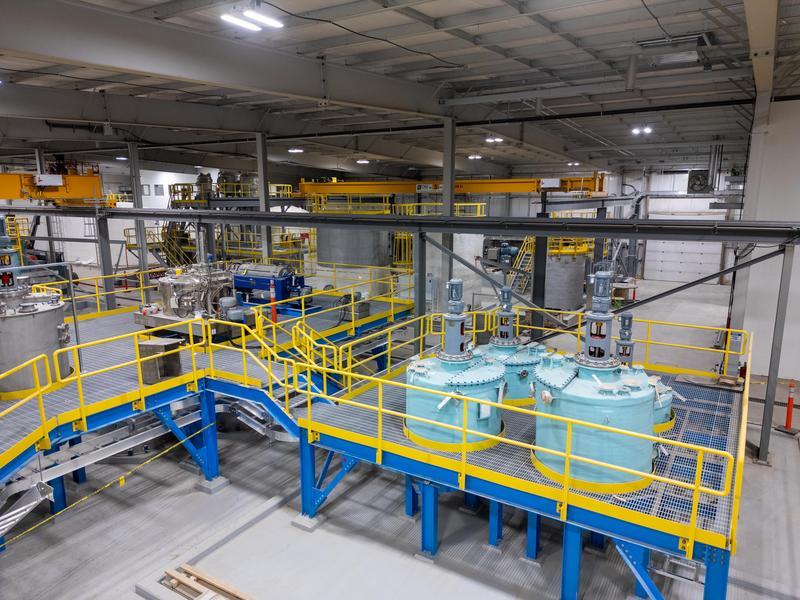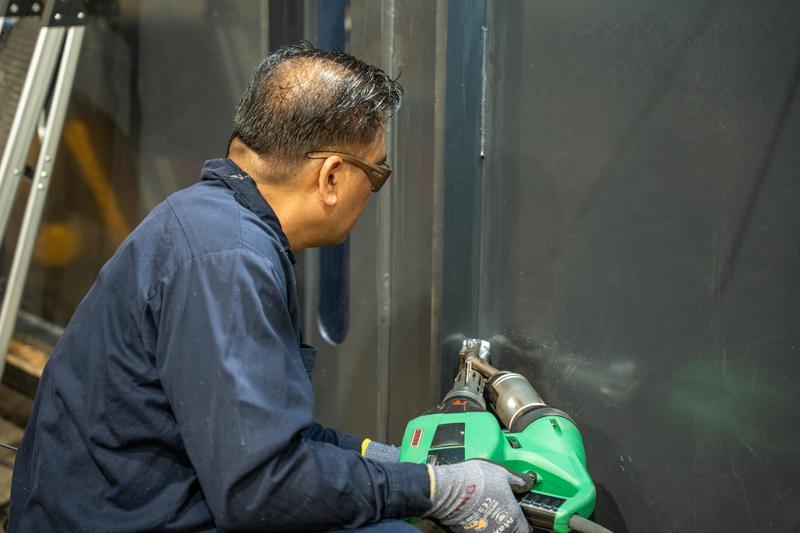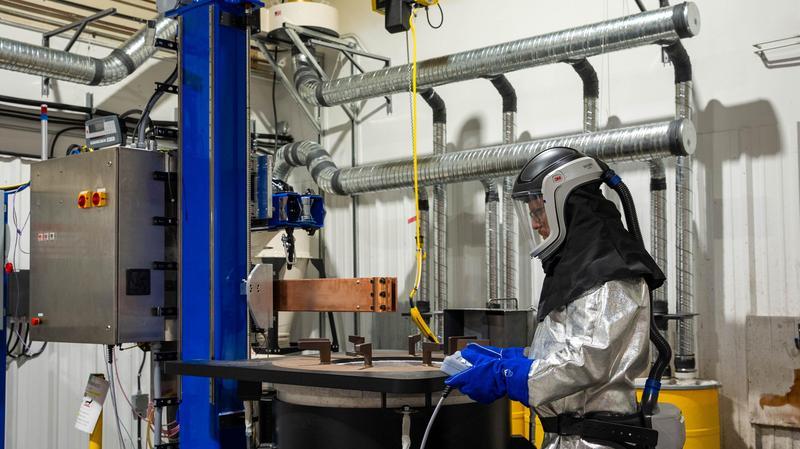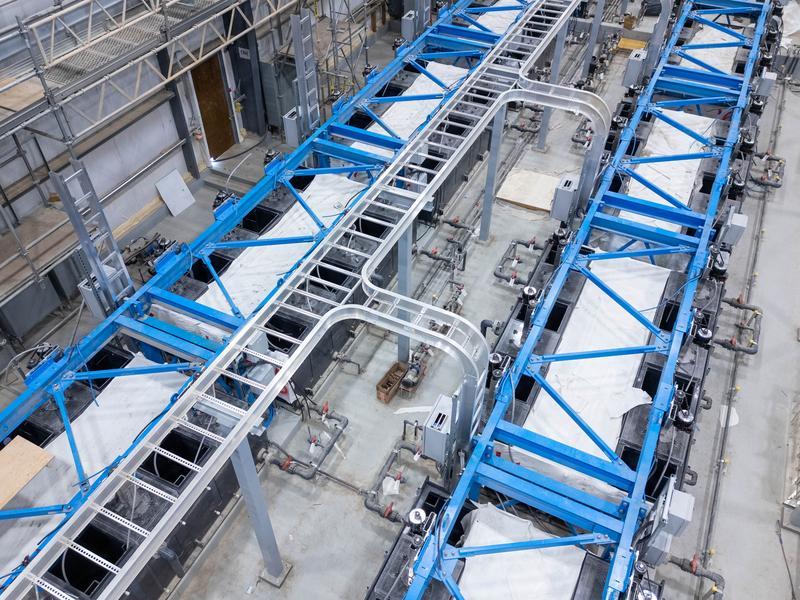
Rare earth elements (REEs) are vital to modern life and the demand for these essential elements is nowhere close to levelling out.
As the need for REEs continues to increase, the Saskatchewan Research Council (SRC) has stepped up to build a fully integrated Rare Earth Processing Facility, complete with hydrometallurgy, separation and metal smelting stages, right here in Saskatchewan. A first of its kind in North America, the facility is delivering on the Government of Saskatchewan’s 2030 Growth Plan and will help to reduce Canada’s dependence on foreign sources of critical minerals.
While REE mining and supply chains are more well-established in other parts of the world like China, it is still an emerging industry in North America – something that has created various challenges for SRC to solve over the last five years of the project.
But this is what SRC does best – develop solutions to complex challenges by drawing on a wealth of knowledge and expertise that spans nearly 80 years. But when it comes to REEs, the bar for innovation is higher than usual.
The name “rare earth elements” can be deceptive. Rare earths aren’t actually rare, but the technologies involved in processing them are an area of research and development that has been ongoing for decades.
It’s not surprising then, given the early stage of the market in North America and the innovation required in technology development, that the scope and timeline of SRC’s facility have expanded since funding for the facility was first announced by the Government of Saskatchewan in 2020.
This is a complex, multi-faceted project that, because of the need to create solutions in the absence of suitable and available alternatives in the market, has required time and resources for SRC to develop state-of-the-art, proprietary technology in-house.
But the creative problem solving doesn’t stop there. From process development, machine learning and artificial intelligence (AI) to business development and procurement of feedstock and equipment – each step involved in developing SRC’s Rare Earth Processing Facility has necessitated a cross-disciplinary, collaborative approach within SRC, but also with industry and stakeholders.
In the years since its announcement and with full operation on the horizon in 2027, the facility has reached many important milestones, showing that progress, while rarely achieved on a straight path, is compromised of many successes along the way.
Keep reading to learn more about how this project started, how it has evolved over the years and what SRC’s plans are for the facility’s promising future ahead.
Getting the Greenlight
In 2020, SRC received funding from the Government of Saskatchewan to begin building a first-of-its-kind commercial demonstration rare earth processing facility to develop REE processing capabilities in Canada – something that is extremely rare outside of China.
“Saskatchewan’s Rare Earth Processing Facility will be a catalyst to stimulate the resource sector in Saskatchewan and across Canada, providing the early-stage supply chain needed to generate cash-flow, investment and industrial growth of the sector,” the Honourable Scott Moe, Premier of Saskatchewan said.
In the beginning, SRC’s Rare Earth Processing Facility was intended to be a commercial demonstration facility – just large enough to prove out the concept domestically and to show that the technology used in markets outside of North America would work at home. The initial facility was intended to only produce rare earth oxides – an intermediary midstream product.
Over the past five years, the facility has expanded to become a highly specialized, fully commercial rare earth processing facility that goes even further down the midstream value chain, producing neodymium praseodymium (NdPr) metal – light REEs – and dysprosium (Dy) and terbium (Tb) metals, a set of heavy REEs.
The REE metals that SRC’s Rare Earth Processing Facility will produce are essential for high-efficiency permanent magnets. These permanent magnets are vital for electric vehicles, wind turbines and defence systems. The facility will produce enough of this metal to power 500,000 electric vehicles annually.
What does this expansion mean for the REE market in Canada? Quicker development and a stronger proof of concept.
“Having the ability to produce commercial-scale metals at our facility gives the rare earth market in Canada a boost. If we had stayed with the commercial demonstration-scale facility, the domestic market would be delayed by waiting for another organization to take the concept proven by SRC and apply it to a fully commercial facility,” says Mike Crabtree, SRC President and CEO. “We’re helping speed up the development of the rare earth industry by building the commercial-scale processing capability right now.”
In the initial planning stages, SRC planned to import existing REE processing equipment from China. However, before ground was broken on SRC’s facility, China restricted exports of this equipment.
Without some of the key REE processing equipment that SRC required for the facility available to purchase, the team had to change plans and determined that in order to proceed, the technology would need to be developed in-house.
While a significant challenge that impacted the project timeline, with decades of expertise in technology development and demonstration for the resource industries, SRC was well-equipped to come up with solutions.
Mixing Things Up
The first step on the technology development checklist for the facility was to develop solvent extraction (SX) cells to help separate out select REEs from monazite feedstock. On the surface, the process is simple – add leached mixed rare earth chloride (MREC) to SX cells, which mix at varying speeds in a set sequence to separate out the target elements – but cracking the exact sequence, speed and number of repetitions of the mixing is as complex as it sounds. Fortunately, SRC already had industry-leading mineral processing experts on staff.
Once the team “cracked the code” on the SX process, SRC began the intricate process of custom-building the SX cells in-house, which are now nearly complete and being installed in the facility.
As the SX cells continued to be manufactured, another requirement for the cells was identified – a system to keep the delicate balance of the cells intact.

Enter SRC’s machine learning and AI experts. A cross-disciplinary team from around the Council stepped in to develop a novel machine learning and AI system that detects imbalances in the system before they result in decreases in production, long before a human would be able to. This system helps ensure the best efficiency and product from the SX cells, with little room for human error.
“Integrating AI with the SX cells was key to making this process both economical and sustainable,” says Crabtree. “The technology’s ability to detect that something is off in the system before a human operator would be able to means that our outputs will be maximized, while limiting downtime that would be expended by manually finding equilibrium again."
What does expanding the facility’s scope to develop in-house proprietary SX cells mean for the REE industry? Improved efficiency and performance compared to existing SX cells in other places around the world and easier access to technology for future facilities.
SRC will be one of a small number of entities in the world that have the capabilities to design and deliver these cells.
Turning Up the Heat
Once the rare earths are separated into individual oxides using the SX technology above, the next step in the process is to smelt certain oxides into rare earth or NdPr metal.
When plans for this portion of the facility were first proposed, the team intended to procure conventional metal smelting furnaces from China, where an REE processing industry was already well established. However, as the team learned more about the technology, they realized that safety was a major concern and a new approach would be required.
Thanks to funding provided by Prairies Economic Development Canada, SRC took the concept of a conventional electric smelting furnace – technology that has existed since the end of the 19th century – and brought it into the 21st century. By integrating automation into the process, SRC has ensured the quality of the product is more consistent, output is increased and, most importantly, the safety of the operators is vastly improved.
Traditional smelting furnaces require an operator to suit up in protective gear, stir the molten REEs and then pour the scalding material into ingot casts – with furnace temperatures soaring to nearly 1100 Celsius, automation has created the need for significantly less operators and more importantly, a safer work environment.
“Safety is our overriding priority in everything we do here, so improving the safety of the furnace operators was of the utmost importance in the process of integrating new technology into the furnaces,” says Crabtree.

SRC has been using its in-house developed, state-of-the-art metal smelting technology to produce commercial grade REE metals since summer 2024, marking Saskatchewan as the first jurisdiction in North America to reach this milestone.
Future in Motion
In April 2025, the Chinese government once again tightened export regulations on certain REE metals, expanding on their previous equipment bans and stifling the global supply since China is firmly in control of the global market. These regulations reinforced the need for a secure, domestic REE supply chain in Canada.
With key parts of SRC’s facility already in commercial production, Saskatchewan – and Canada – are positioned to emerge as leaders in the industry. SRC has feedstock supply agreements for monazite from Brazil and South Africa and has also already completed multiple toll-processing agreements, allowing for REE metals to be delivered at a commercial scale to clients in both Canada and Europe.
SRC’s Rare Earth Processing Facility is scheduled to complete the commissioning process throughout 2026 and reach fully integrated operation in 2027. In the meantime, SRC continues to produce REE metals, is pursuing additional toll-processing and service agreements and is also considering the commercialization of its SX cells and metal smelting units.

“We’re excited to be at the forefront of this burgeoning industry in Canada,” says Crabtree. “We look forward to continuing to innovate and evolve as the REE market develops.”
As the North American REE market continues to evolve, the team is also exploring the opportunity to expand the facility to process recycled REE magnets. This additional expansion will take end-of-life rare earth magnets and separate them back into REE metals, adding additional material into the global supply chain and building circularity and increased long-term sustainability.
Another cutting-edge process to build resiliency into SRC’s Rare Earth Processing Facility, allowing it to adapt to market volatility.
Want to stay up to date on the progress of SRC’s Rare Earth Processing Facility? Visit our webpage and subscribe to our newsletter!
